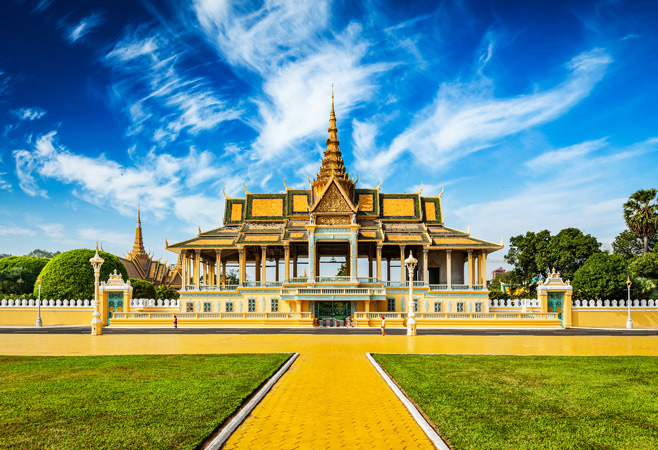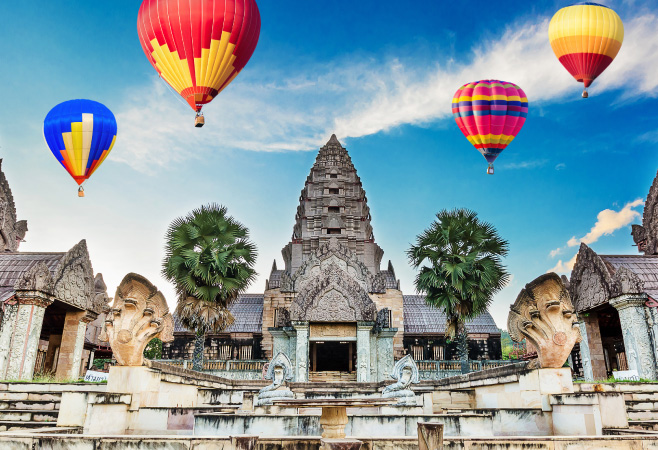Discover Angkor Wat in Cambodia - Place must visit for travelers
Angkor Wat is a temple complex in Cambodia and is the largest religious monument in the world, on a site measuring 162.6 hectares. This is considered a must-visit place of any tourist when visiting Cambodia due to its ancient beauty.
Join with Cambodia Immigration Service to find out more detailed information about this tourist destination!

Angkor Wat is the most well-known ancient temple structure in Cambodia
1. What do you know about Angkor Wat in Cambodia?
Angkor wat history is interesting. Angkor Wat is a temple complex in Cambodia and the world's largest religious monument. This is one of the most spectacular archaeological sites in Asia.
Where is Angkor Wat?
Angkor Wat is located at Krong Siem Reap, Cambodia, was known as the capital of the Khmer empire.
When was Angkor Wat built?
Angkor Wat was built in the early 12th century at an area of 163 ha. Construction is thought to have taken three decades.
Who built Angkor wat and why?
Angkor Wat was built by Suryavarman II, as a palace of Vishnu, who was enshrined there to allow the founder to receive his beneficence.
How old is Angkor Wat?
As Angkor Wat history, It was built by the Khmer King in the first half of the 12th century, around the year 1110-1150. So, it makes Angkor Wat almost 900 years old.
What is Angkor Wat famous for?
Angkor Wat's architectural style is Khmer style. This is the most famous ancient temple site in Cambodia. With its 5 lotus-like towers rising 65 meters into the sky, it is an awe-inspiring sight.
In 1992, the Angkor Archaeological Park was certificated as a UNESCO World Heritage Site. And new ruins are discovered frequently.

Discover the origins about Angkor Wat
2. Top 7 Angkor wat temple to see
The most popular Angkor temples are as follows:
Angkor Wat (main site)
Angkor Wat is the largest of all the Angkor temples, as known a prime example of classical Khmer design.
This "City temple" is located on an enormous site of 494 acres. A massive rectangular moat surrounds the temple, which rises 669 feet through a series of terraces to the central shrine.
Inside, Angkor Wat represents Mount Meru, the Hindu gods' home. On the first level, bas-reliefs depict Hindu epics such as the mythical "Churning of the Ocean of Milk," a legend in which Hindu deities stir vast oceans in order to extract the nectar of immortal life.
The reliefs, which include thousands of female dancers, are carved into the wall of the temple's third enclosure. The legendary sunrise at Angkor Wat is every bit as breathtaking as you might expect. As a result, the sunrise point at Angkor Wat has attracted a large number of visitors.
Bayon
The magnificent Bayon temple has been one of the last temples to be built at Angkor since 1190 AD.
The Bayon temple is famous for its 216 massive stone faces that face all directions. The Bayon climbs three levels to a height of about 140 feet.
The first level contains some well-preserved bas-reliefs believed to depict scenes from everyday life and historical events. The next higher level's inner gallery depicts mythical figures and stories. The third level is where you'll run into the faces that surround you.
Banteay Srei
Banteay Srei, also known as Banteay Srey, means "Citadel of the Women" because the intricate carvings are allegedly too fine for a man's hand. Banteay Srei is a Cambodian temple from the tenth century dedicated to the Hindu god Shiva.
Banteay Srei is a small temple in comparison to some of the other temples. The temple walls, made of fine-grained, rose-pink sandstone, are elaborately decorated with floral motifs and epic Ramayana scenes, making it a jewel of Khmer art.
Phnom Bakheng
Phnom Bakheng has historical importance. This is a Hindu and Buddhist temple shaped like a temple mountain. This Shiva temple was built between the late ninth and early tenth centuries and is one of the oldest in the area.
It is built in the shape of a pyramid with six tiers facing east. It once had 108 small towers, but only a few of them remain. From the top, you can see all the way to Angkor Wat, and Phnom Bakheng's also a great place to watch the sunset.
Ta Prohm (the Tomb Raider temple)
Ta Prohm, originally known as Rajavihara, was constructed primarily in the late 12th and early 13th centuries in the Bayon style. Ta Prohm is one of the most beautiful temples in Angkor Wat.
Ta Prohm is said to be the first sandstone structure, with a five-tiered pyramid and steep staircases on each side. More than 12,500 people lived in the temple, including 18 high priests, and an additional 80,000 Khmers from surrounding villages were needed to keep the temple running.
Ta Prohm has been known as the atmospheric setting for the action film Tomb Raider since 2001.
Giant trees and tree roots are intertwined with crumbling stone structures, creating an eerie atmosphere.
Banteay Kdei
Banteay Kdei means "Citadel of Chambers," but it is also known as "Citadel of Monks' Cells" or "Citadel of Cells." Banteay Kdei is located east of Angkor Thom and southeast of Ta Prohm. The temple was most likely built in the 12th century, and after the Khmer Empire fell apart, it was abandoned and overgrown for hundreds of years. Little is known about this enigmatic temple.
Angkor Thom
Angkor Thom, also known as Nokor Thom, was the Khmer Empire's final and most enduring capital city. King Jayavarman VI established it in the late twelfth century.

Cambodia is a country famous for its temples that stand as the epitome of antiquity
3. Amazing things in Angkor Wat must try
The best time to visit Angkor Wat is between November and April when it is dry. Below is a list for travelers to do once in their life if you plan to visit Angkor Wat temples. Let's check it out!
- Admire the majestic beauty of the Angkor temples
- Pay a visit to the Landmine Museum
- See Authentic Life at Kampong Phluk floating village
- Explore the Prek Toal Bird Sanctuary
- Wander through the Angkor National Museum
- Eat bugs at the Old Market
- Get a fishy foot massage
- Horse riding in Siem Reap Countryside
- Join a Khmer cooking class
- Take a hot air balloon flight
- Party at the Pub Street
- Check out Miss Wong’s Cocktail Bar
- Go shopping in the Angkor night market
- Enjoy a traditional Apsara dance

Taking a hot air balloon is the most interesting way to witness the panoramic view of Angkor Wat
4. Angkor Wat Travel Guide
Visit Angkor Wat is one of the must things to do in Cambodia for any visitors. To make sure you have the most complete and economical Angkor Wat experience, do not miss our interesting information below.
Where to stay in Angkor Wat?
Travelers stay in Siem Reap when they’re visiting Angkor Wat.
How to get around Angkor Wat?
There are two ways for visitors to get to and from Angkor Wat (and around the complex):
- Bicycle Rental: about $5 USD per day.
- Tuk-tuks: can find it everywhere. Drivers cost around $25 USD per day and have room for 3-4 people.
When to go to Angkor Wat?
Angkor Wat is open year-round. But the best time to visit is the dry season from late November to early April.
- December and January are best for weather, but they’re also the busiest months.
- April and May are very hot, with tons of humidity. The average daily temperature in April is 31°C (88°F).
- The hottest months are from late May/June to the end of October, and September and October.
The best way to save cost for the Angkor Wat trip
Here are a few of the top money-saving tips for Angkor Wat:
- Get a multi-day pass – Everyone needs a permit to enter the Angkor temples unless you are Cambodian.
- Rent a tuk-tuk for an entire day to get around. They know how to get you in and out of each temple as well as the best routes for the complex.
- If you split this between a group of 3-4 it becomes quite affordable. Getting a driver in Siem Reap is cheaper than inside the park.
- The best way to spend this extra time is to watch the sunset and buy your ticket after 5 pm. That means you can legally enter the park without using up your allotted days.
- Bring a water bottle to save money and reduce your plastic use.
It is wonderful to admire the sophisticated and majestic Khmer architecture. The majestic scenery of the ancient Khmer empire will help you better understand the period of the history of Cambodia.
Hope the information in this article will help you have a more detailed plan to visit Angkor Wat in Cambodia. Do not forget to contact our Cambodia online visa service to get the fastest entry to this country.









